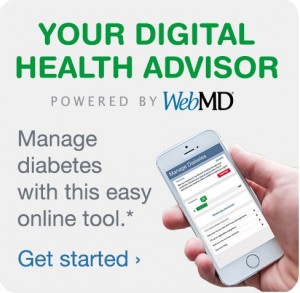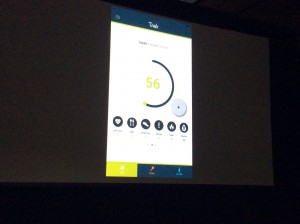 The fastest-growing category of products and services at Health 2.0 is consumer-facing digital health, and a panel of companies demonstrated various flavors of the New Retail Health.
The fastest-growing category of products and services at Health 2.0 is consumer-facing digital health, and a panel of companies demonstrated various flavors of the New Retail Health.
One of the most prominent companies featured in Health 2.0’s conferences from the inception has been MyFitnessPal (MFP), a long-time helpful tool I’ve used to manage my own health-life. Under Armour acquired MFP earlier this year, which I covered here in Health Populi.
Under Armour’s original mission was to make all athletes better. With the company’s acquisition of MyFitnessPal, Under Armour continued its morphing from a textile and sports gear company to a digital health company where wearable tech and health data play a growing role. Albert Lee, Co-Founder of MFP with his brother Mike Lee, discussed this evolution on Day 2 at Health 2.0. Smart apparel is a growing category, and Health 2.0 features more of it in this, the 9th year of the conference. You can see my interview with Al and Mike from last year’s Health 2.0 Conference here.
 Greg Orr, Senior Director of Digital Health at Walgreens, talked about the company’s growing consumer health portfolio. Walgreens has been working with WebMD on health management tools consumers can use to manage diabetes and overall health. Walgreens also works with MDLive as a telehealth provider (for $49 per virtual visit) and PatientsLikeMe’s “tremendous database of over 300,000 patients” with whom Walgreens can work to answer questions about drug-drug interactions in “real,” everyday people. This isn’t to supplant the role of the FDA, Orr said, but to enhance what’s available to health consumers. Remember: PatientsLikeMe’s tagline is “Live Better, Together.”
Greg Orr, Senior Director of Digital Health at Walgreens, talked about the company’s growing consumer health portfolio. Walgreens has been working with WebMD on health management tools consumers can use to manage diabetes and overall health. Walgreens also works with MDLive as a telehealth provider (for $49 per virtual visit) and PatientsLikeMe’s “tremendous database of over 300,000 patients” with whom Walgreens can work to answer questions about drug-drug interactions in “real,” everyday people. This isn’t to supplant the role of the FDA, Orr said, but to enhance what’s available to health consumers. Remember: PatientsLikeMe’s tagline is “Live Better, Together.”
Walgreens’ Your Digital Health Advisor program (which I regularly use and connect with my wearable tracking devices) enables consumers to track exercise, weight, blood pressure, blood glucose and other metrics for overall health and wellbeing. This links to the company’s loyalty program, Balance Rewards, which earns consumers points for multi-tasking health choices on a daily basis, adding up to dollars that can be spent at Walgreens stores or on the online ecommerce portal.
Withings recognizes that home is an extension of our health, Arielle Carpenter of Withings noted in her demo of the company’s new home security camera-cum-environmental sensor which track compounds at home that can be harmful to health. The device works with an app which portrays parts-per-million of the air quality components, which may be attractive to a “Green Mom,” “Tech Savvy Dad,” etc., Carpenter says.
Orr of Walgreens notes the concept of the “Sick Home” which doctors are increasingly paying attention to for overall health moving beyond the physician’s office. This is particularly useful for managing environmental-exacerbated conditions like asthma, COPD and other respiratory issues.
 Sandstone Diagnostics’ CEO Greg Sommer is supporting people in their goal to bolster reproductive health and fertility — with a focus on men. It’s called Trak and works to improve men’s sperm quality at home. The product includes a home-scaled centrifuge which measures sperm count, which will be available over-the-counter in 2016. There’s also a Trak mobile app, shown here, illustrating wellness, diet, exercise, stress, heat and toxins which impact male fertility. The impotance of consumer education is crucial for men’s health, so Trak offers an online hub of informaton (website URL at “don’t cook your balls dot com”) offering humor, appropriately, to info-tain and empower.
Sandstone Diagnostics’ CEO Greg Sommer is supporting people in their goal to bolster reproductive health and fertility — with a focus on men. It’s called Trak and works to improve men’s sperm quality at home. The product includes a home-scaled centrifuge which measures sperm count, which will be available over-the-counter in 2016. There’s also a Trak mobile app, shown here, illustrating wellness, diet, exercise, stress, heat and toxins which impact male fertility. The impotance of consumer education is crucial for men’s health, so Trak offers an online hub of informaton (website URL at “don’t cook your balls dot com”) offering humor, appropriately, to info-tain and empower.
Health Populi’s Hot Points: In this 9th year of the Health 2.0 Conference, the consumer’s role in self-care has never been more prominent or more central. This speaks to the evolution of more patient-centered health in the overall healthcare system, but also U.S. consumers’ growing role as health care financers through high-deductible health plans and clinical decision makers. These digital health tools, available through trusted retail branded channels like Under Armour and Walgreens, are the beginning of a larger movement of collaborative health care: people/patients co-creating health in their home and workplace, with the support of the healthcare system of doctors, hospitals, and allied health professionals when acute care is needed. A key bridge across this consumer/healthcare chasm will be the pharmacist and pharmacy, an opportunity which Walgreens and its fierce competitors CVS, Rite-Aid, big box and grocery store pharmacies are already building on.




 Thank you FeedSpot for
Thank you FeedSpot for